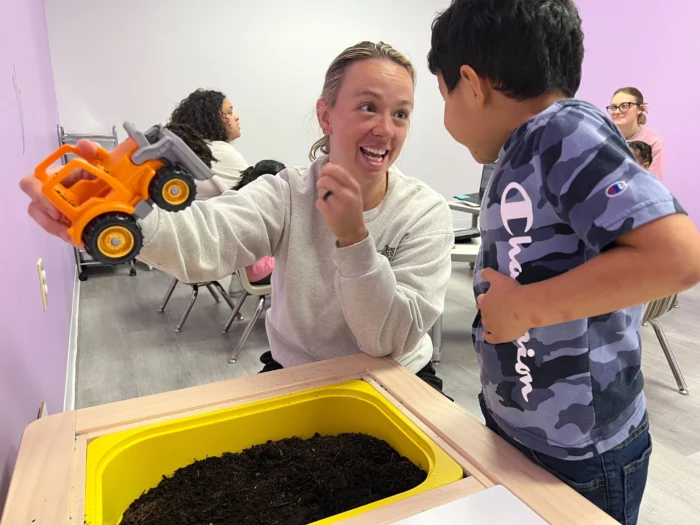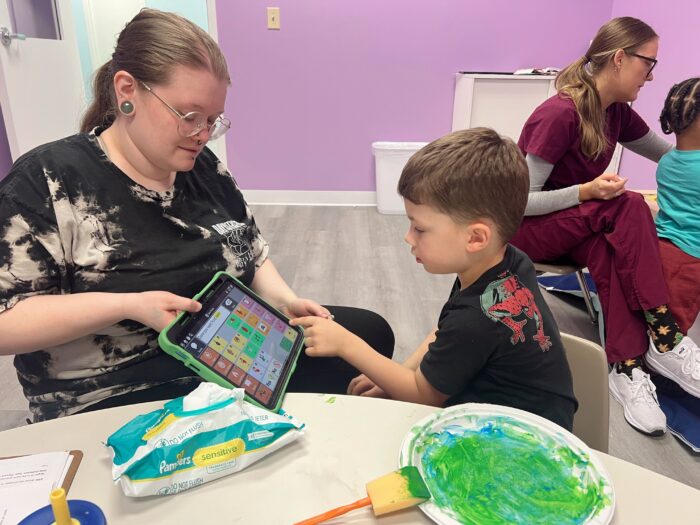
Are you feeling overwhelmed about where to start with autism treatment? We want you to know that you’re not alone. At Abacus Therapies, we understand the mix of emotions that come with exploring treatment options for your child.
In this article, we’ll guide you through how ABA therapy works, from its foundations to today’s child-centered approaches, and address the questions we hear most often from parents. We’ll also share practical tips about navigating insurance coverage because we know that’s an important part of the journey too.
ABA Therapy: Meaning and Main Elements
At its heart, Applied Behavior Analysis (ABA) is about understanding how your child learns and interacts with their world. In simple terms, ABA is a scientific approach that focuses on helping your child develop social, communication, and learning skills in ways that allow them to feel supported and loved.
Since its emergence in the 1960s, ABA therapy has evolved significantly, becoming a well-regarded approach that puts your child’s unique needs and personality at the center of treatment.
The key elements that make ABA therapy effective include:
- Understanding behavior: We look at how your child’s environment influences their learning and behavior, helping us create positive learning experiences.
- Personalized approach: Every child is unique, which is why we adapt our methods to fit your child’s interests and needs.
- Versatile application: While particularly helpful for autism, ABA can support children with various needs, including ADHD, Down syndrome, and anxiety.
- Positive reinforcement: We celebrate your child’s successes, using rewards that matter to them to encourage continued growth.
- Family partnership: We believe parents are experts on their children, which is why we work closely with families to ensure progress continues beyond therapy sessions.
Who Does ABA Therapy?

Your child’s therapy team is led by Board-Certified Behavior Analysts (BCBAs), professionals who are specially trained to create and oversee personalized treatment programs.
The Scope and Effectiveness of ABA Therapy
We’ve seen firsthand how ABA therapy can help children develop skills and independence, and research supports these observations. The American Psychological Association recognizes ABA’s effectiveness across different age groups, from young children to adults.
Also, a 2005 study found that 48% of children on the autism spectrum showed significant improvements in learning and test scores after receiving ABA therapy. Another study demonstrated that children participating in at least 25 hours of weekly ABA therapy made notable progress in their learning abilities.
Beyond the statistics, what matters most is seeing families feel supported in their daily lives and that children feel loved. At Abacus Therapies, we witness these successes every day as children learn to communicate their needs, connect with others, and grow in confidence.
How to Start with ABA Therapy
Beginning ABA therapy is an important step, and we’re here to support you through every phase of the journey:
- Getting to know your child: We start with a thorough assessment to understand your child’s unique needs and interests.
- Creating a personalized plan: Based on what we learn, we develop a treatment plan that aligns with your child’s characteristics.
- Working together: We collaborate with you, your child’s teachers and other caregivers to ensure consistent support across all environments.
The frequency and length of sessions vary based on your child’s needs, typically ranging from 10-40 hours weekly for children. We’ll work with you to find the right schedule for your family.
The Crucial Role of Positive Reinforcement

In ABA therapy, we use positive reinforcement in structured ways to help your child learn and grow. Think about how your child’s face lights up when you praise their efforts – that’s positive reinforcement in action. By celebrating their successes, whether big or small, we create an encouraging environment where learning feels rewarding and fun.
Major ABA Techniques
Our approach to ABA therapy draws from several proven techniques, each designed to support your child’s development in ways that feel natural and engaging.
Here are the key methods we use:
- Early Start Denver Model (ESDM): Perfect for our youngest learners (ages 12-48 months), ESDM makes learning feel like play. Picture your toddler building crucial cognitive, social, and language skills while having fun with activities they love. We’ve seen children’s faces light up as they master new skills through games and interactive play.
- Discrete Trial Training (DTT): Think of this as breaking down big tasks into small, achievable steps. We present a clear prompt, help your child respond, and celebrate their success. For example, if your child is learning to request items, we might start with simple gestures and gradually work up to using words, celebrating each step along the way.
- Natural Environment Teaching (NET): Learning shouldn’t be confined to a therapy room. NET helps your child use their skills in everyday situations – at home, at the playground, or during family meals. This approach ensures that skills learned during therapy become part of your child’s daily life.
- Early Intensive Behavioral Intervention (EIBI): For our younger children, this comprehensive approach focuses on building fundamental skills in communication, social interaction, and daily living. We tailor the intensity and focus to match your child’s developmental stage and family’s needs.
- Pivotal Response Treatment (PRT): This method taps into your child’s natural motivation to learn. By following their interests and celebrating their initiatives, we help them develop crucial skills while staying engaged and excited about learning.
No two children are alike, so we adapt our approach to match your child’s unique needs and learning style.
Implementing ABA Therapy in Different Contexts
One of the perks of ABA therapy is its flexibility. Whether at home, school, or in the community, we adapt our approach to fit naturally into your child’s world. You can choose between:
- Comprehensive ABA Treatment: We work with you to create a program that addresses various skills in different settings, ensuring your child has the support they need throughout their day.
- Focused ABA Treatment: Sometimes, families prefer to concentrate on specific skills. These one-on-one sessions allow us to work intensively on particular areas that matter most to your child’s development.
What Does ABA Therapy Look Like?
Let’s look at some real-world examples of how ABA therapy works in practice. These scenarios show how we use structured, personalized strategies to support your child’s growth:
- Scenario 1: Imagine a therapy session where a child who struggles with verbal communication wants their favorite toy car. Instead of immediately giving them the toy, the therapist creates an opportunity for communication. They might hold up the car (the prompt), wait for the child to try asking for it (the response), and then celebrate their communication attempt by giving them the car along with enthusiastic praise (the reward).
- Scenario 2: Consider a classroom setting where a child finds it challenging to stay seated during lessons. Working with the teacher, we might introduce a simple timer system. When the timer starts (the signal), the child knows it’s time to stay in their seat. If they succeed until the timer rings, they earn a special reward like extra time with a favorite activity. Over time, this helps build positive classroom habits.
Understanding Modern ABA Therapy

We believe in being transparent about ABA therapy’s evolution. While some voices in the autism and neurodiversity community have raised concerns about historical ABA practices, today’s approach is fundamentally different.
- Celebrates each child’s unique personality and strengths
- Respects neurodiversity and individual differences
- Uses engaging, flexible, and child-led methods
- Focuses on skills that enhance quality of life
- Partners with families to ensure goals align with their values
At Abacus Therapies, we’re committed to a respectful, child-centered approach that helps each person develop skills while honoring their way of being in the world.
ABA Costs and Insurance
We understand that financial considerations are an important part of your decision-making process. The good news is that ABA therapy is typically considered a healthcare service and is often covered by insurance.
Here’s what you need to know:
- Most private health insurance plans include coverage for ABA therapy
- Medicaid generally covers ABA therapy for children under 21 when medically necessary
- Coverage details vary by state and provider
- State-funded programs and grants may be available to help with costs
We’re here to help you navigate the insurance process. Our team can help you understand your coverage options and explore available resources. Don’t hesitate to reach out to us with questions about insurance coverage or financing options.
Final Thoughts
At its core, ABA therapy is about helping each person with autism reach their fullest potential in ways that feel authentic to them. As parents ourselves, we understand that what matters most is seeing our children grow up happy and loved and that they find their place in the world. We’re committed to creating custom ABA therapy plans that are as unique as your child’s.
If you’re considering ABA therapy, we’d love to learn about your child and discuss how we might help them grow and connect with their world in meaningful ways. Contact us today!
FAQs
What does ABA do for autism?
ABA therapy helps children develop important life skills while honoring their unique way of experiencing the world. We focus on building communication and social skills, making learning manageable and meaningful for each child.
What is an example of ABA therapy?
In a typical session, we might work on communication skills through play. For instance, if your child loves trains, we might create opportunities for them to ask for different trains or tracks, celebrating each attempt at communication while making the activity fun and engaging.
What are the pros and cons of ABA therapy?
The main benefits include personalized skill development and feeling supported as they grow up. The intensive nature of therapy can be challenging to balance with other commitments, which is why we work closely with families to create schedules that work for them.
How long does a child need ABA therapy?
Each child’s journey is unique. While some children might start with 20-40 hours weekly, we adjust the schedule based on their progress and your family’s needs. At Abacus Therapies, we create programs that match your child’s specific needs and celebrate their progress every step of the way.



